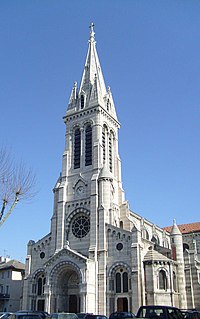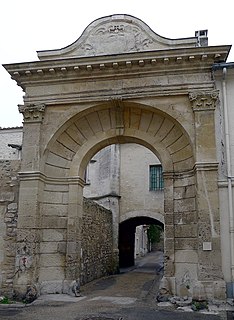Related Research Articles
Pope Zosimus was the bishop of Rome from 18 March 417 to his death on 26 December 418. He was born in Mesoraca, Calabria. Zosimus took a decided part in the protracted dispute in Gaul as to the jurisdiction of the See of Arles over that of Vienne, giving energetic decisions in favour of the former, but without settling the controversy. His fractious temper coloured all the controversies in which he took part, in Gaul, Africa and Italy, including Rome, where at his death the clergy were very much divided.

Lothair II was the king of Lotharingia from 855 until his death. He was the second son of Emperor Lothair I and Ermengarde of Tours. He was married to Teutberga, daughter of Boso the Elder.

Caesarius of Arles, sometimes called "of Chalon" from his birthplace Chalon-sur-Saône, was the foremost ecclesiastic of his generation in Merovingian Gaul. Caesarius is considered to be of the last generation of church leaders of Gaul that worked to promote large-scale ascetic elements into the Western Christian tradition. William E. Klingshirn's study of Caesarius depicts Caesarius as having the reputation of a "popular preacher of great fervour and enduring influence". Among those who exercised the greatest influence on Caesarius were Augustine of Hippo, Julianus Pomerius, and John Cassian.

The Roman Catholic Archdiocese of Rouen is an archdiocese of the Latin Rite of the Roman Catholic Church in France. As one of the fifteen Archbishops of France, the Archbishop of Rouen's ecclesiastical province comprises the greater part of Normandy. The Archbishop of Rouen is currently Dominique Lebrun.

The Archdiocese of Bordeaux (–Bazas) is a Latin Church ecclesiastical territory or archdiocese of the Catholic Church in France. The episcopal see is Bordeaux, Aquitaine. It was established under the Concordat of 1802 by combining the ancient Diocese of Bordeaux with the greater part of the suppressed Diocese of Bazas. The Archdiocese of Bordeaux is a metropolitan see, with four suffragan dioceses in its ecclesiastical province: Dioceses of Agen, Aire and Dax, Bayonne, and Périgueux.

The Diocese of Gap and Embrun is a Latin Church ecclesiastical territory or diocese of the Catholic Church in Provence-Alpes-Côte d'Azur region of Southern France.

The Archdiocese of Aix-en-Provence and Arles is a Latin Church ecclesiastical territory or archdiocese of the Catholic Church in France. The archepiscopal see is located in the city of Aix-en-Provence. The diocese comprises the department of Bouches-du-Rhône, in the Region of Provence-Alpes-Côte d'Azur. It is currently a suffragan of the Archdiocese of Marseilles and consequently the archbishop no longer wears the pallium.
The Archbishopric of Vienne, named after its episcopal seat in Vienne in the Isère département of southern France, was a metropolitan Roman Catholic archdiocese. It is now part of the Archdiocese of Lyon.

The Ancient Diocese of Vaison was a Roman Catholic diocese in France, suppressed in 1801, with its territory transferred to the diocese of Avignon. It had been one of nine dioceses in the ecclesiastical province presided over by the archbishop of Arles, but a later reorganization placed Vasio under the archbishop of Avignon. Jurisdiction inside the diocese was shared between the bishop and the Comte de Provence, higher justice and the castle belonging to the Comte, and civil justice and all other rights belonging to the bishop. The cathedral was served by a chapter which had four dignities: the provost (praepositus), the archdeacon, the sacristan, and the precentor. There were also six canons, each of whom had a prebend attached to his office.

The Roman Catholic Archdiocese of Embrun was located in southeastern France, in the mountains of the Maritime Alps, on a route that led from Gap by way of Briançon to Turin. It had as suffragans the Diocese of Digne, Diocese of Antibes and Grasse, Diocese of Vence, Diocese of Glandèves, Diocese of Senez and Diocese of Nice. Its see was the Cathedral of Nôtre Dame in Embrun.

The ancient residential diocese of Orange in the Comtat Venaissin in Provence, a fief belonging to the Papacy, was suppressed by the French government during the French Revolution. It was revived in 2009 as a titular see of the Roman Catholic Church.

The former French Catholic diocese of Chalon-sur-Saône existed until the French Revolution. After the Concordat of 1801, it was suppressed, and its territory went to the diocese of Autun. Its see was Chalon Cathedral.
Bertrand de Saint-Martin was a French cardinal.

Nectarius of Digne was believed to have been the third Bishop of Digne, the first bishop of Digne having been Saint Domnin and the second Saint Vincent. However, Pierre Gassendi considers it likely that an unknown bishop succeeded Saint Vincent as predecessor to Nectarius, making Nectarius the fourth bishop of Digne.
Wenilo was the archbishop of Rouen from 858. He was an appointee of King Charles the Bald.

Adventius was the Bishop of Metz from 855 until his death in 875. He was a prominent figure within the courts of the Carolingian kings Lothar II (855–869) and Charles the Bald (840–877).

Saint-Césaire Convent, at first called Saint-Jean monastery, was a nunnery in the city of Arles in the south-eastern corner of the rampart. It was founded in 512 AD. Its name was later changed to Abbaye Saint-Césaire in honor of its first abbess, Caesaria of Arles, and it remained until the French Revolution. Later what remained of the buildings were used as a hospice.
Theodosius of Arles, was Archbishop of Arles c. 632–650.
Rostang of Arles was Archbishop of Arles from 870 to 913. He supported the coup d'état of Boso of Provence against the Carolingians in 879.
Saint Verus of Vienne or Verus I of Vienne, is a saint of the Catholic church and a 4th-century bishop of Vienne in France.
References
- Gilles Duport - Histoire de l'Église d'Arles – 1690
- Michel Baudat et Claire-Lise Creissen - Les Saints d'Arles - Rencontre avec le Patrimoine religieux, 2013
- G. de Rey, Les invasions des sarrasins en Provence pendant le VIIIe, le IXe et le Xe siècle, Marseille, 1878
- Annales Bertiniani s.a. 865, 869.